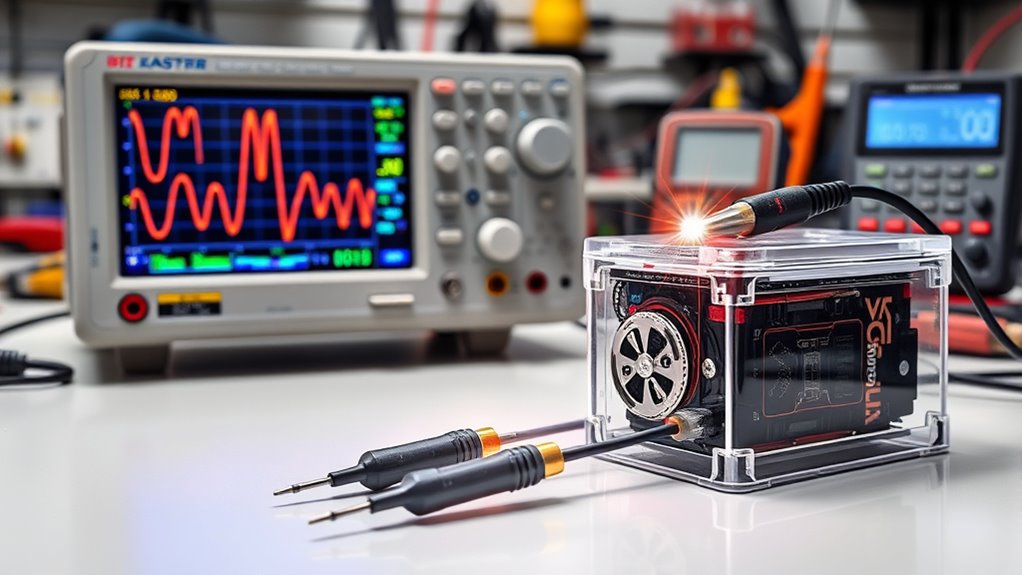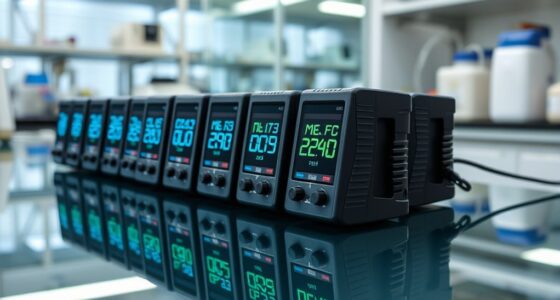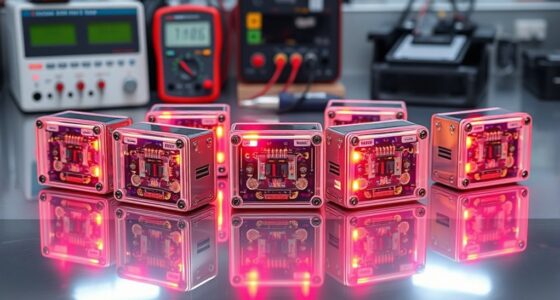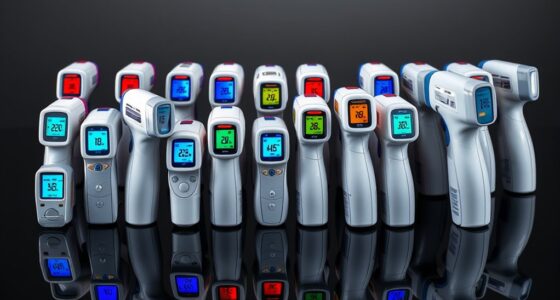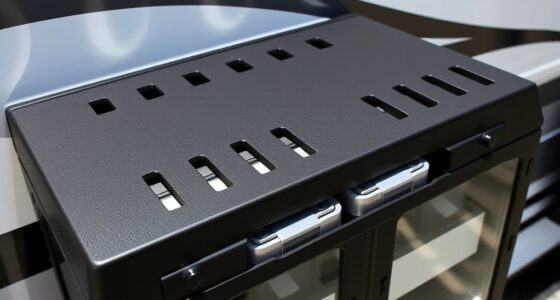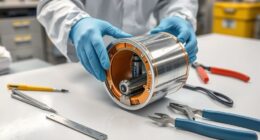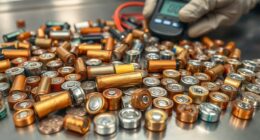If you’re looking for the best oscilloscopes for battery diagnostics in 2025, I recommend considering portable units with high bandwidth, rechargeable power, and user-friendly interfaces. Models like the FNIRSI 1013D Plus and Hantek series offer accurate waveform capture, multiple channels, and versatile testing features suitable for automotive, high-voltage, or electronics work. If you continue, you’ll discover more about selecting the perfect device to confidently diagnose and analyze your batteries.
Key Takeaways
- Portable oscilloscopes with high voltage probes ensure safe, accurate battery voltage and current testing in the field.
- Models with high sampling rates (≥1 GSa/s) enable detailed waveform analysis of battery charge/discharge cycles.
- Devices supporting digital protocols (I2C, CAN) assist in diagnosing embedded systems linked to batteries.
- User-friendly interfaces and waveform storage simplify testing for both professionals and hobbyists.
- Compact, lightweight designs facilitate on-site diagnostics with long-lasting batteries for extended use.
FNIRSI 1013D Plus Portable Oscilloscope with High Voltage Probe
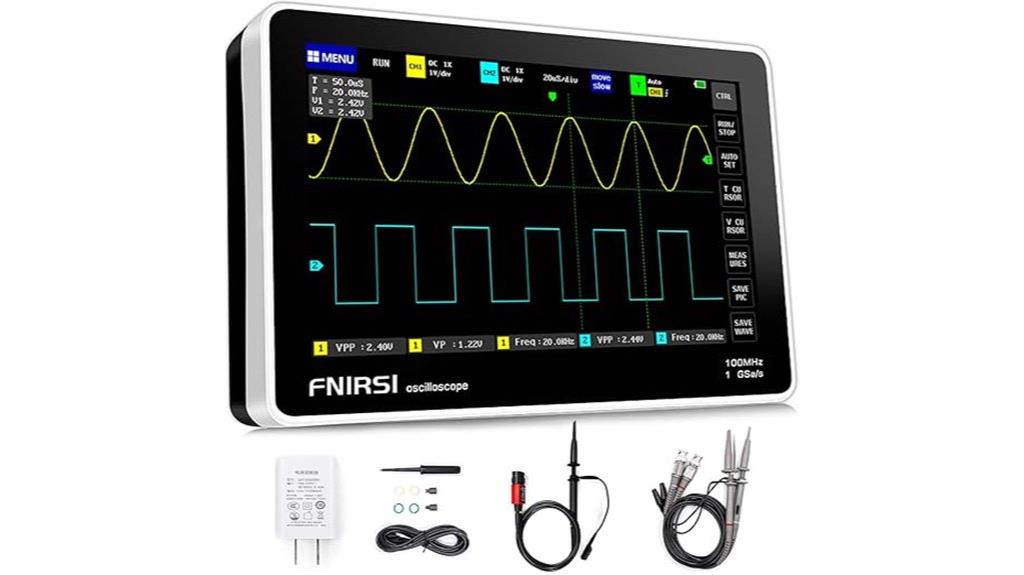
If you’re looking for a portable oscilloscope that’s ideal for field testing and high-voltage battery diagnostics, the FNIRSI 1013D Plus is a strong choice. It features a 7-inch TFT LCD touch screen, 2 channels, 100 MHz bandwidth, and a 1 GSa/s sampling rate, making it versatile for various signals. The device includes a 100X high-voltage probe rated up to 4000 V, perfect for high-voltage measurements. Its compact, lightweight design with a built-in 6000 mAh battery provides around 4 hours of use. Safe and easy to operate, it’s well-suited for on-the-go diagnostics, especially in environments where portability and high-voltage safety matter.
Best For: hobbyists, field technicians, and high-voltage experimenters seeking a portable, easy-to-use oscilloscope for basic signal analysis and high-voltage measurements.
Pros:
- Compact, lightweight design with built-in rechargeable battery for on-the-go use.
- High-voltage probe rated up to 4000 V, ideal for safe high-voltage measurements.
- User-friendly touch screen interface with waveform storage and multiple trigger options.
Cons:
- Manual calibration and trigger adjustments can be inconsistent or challenging.
- Touchscreen responsiveness may deteriorate over time or with heavy use.
- Not suitable for precise, professional-grade measurements due to limited calibration options and potential inaccuracies.
Hantek 1008C PC USB 8-Channel Automotive Diagnostic Oscilloscope

The Hantek 1008C PC USB 8-Channel Automotive Diagnostic Oscilloscope is an excellent choice for beginners and hobbyists who need a cost-effective tool for basic vehicle diagnostics. It offers over 80 diagnostic functions, including testing ignition, sensors, and charging circuits. The device is easy to set up with presets and works well for low-voltage signals, making it suitable for casual diagnostics. While its software can be clunky and prone to connection issues, it’s manageable with online tutorials. Overall, it’s a budget-friendly, straightforward scope, perfect for those starting out or performing occasional vehicle testing.
Best For: beginners and hobbyists seeking an affordable, easy-to-use automotive diagnostic oscilloscope for basic vehicle testing.
Pros:
- Cost-effective solution for entry-level diagnostics with over 80 functions
- Easy setup with presets suitable for casual users and beginners
- Compatible with Windows and includes online tutorials for troubleshooting
Cons:
- Software can be clunky, unstable, and prone to disconnections during use
- Hardware limitations such as low-quality leads and noise pickup issues
- Limited performance for high-speed signals and professional-grade diagnostics
Hantek 1008B 8-Channel Automotive Diagnostic Oscilloscope
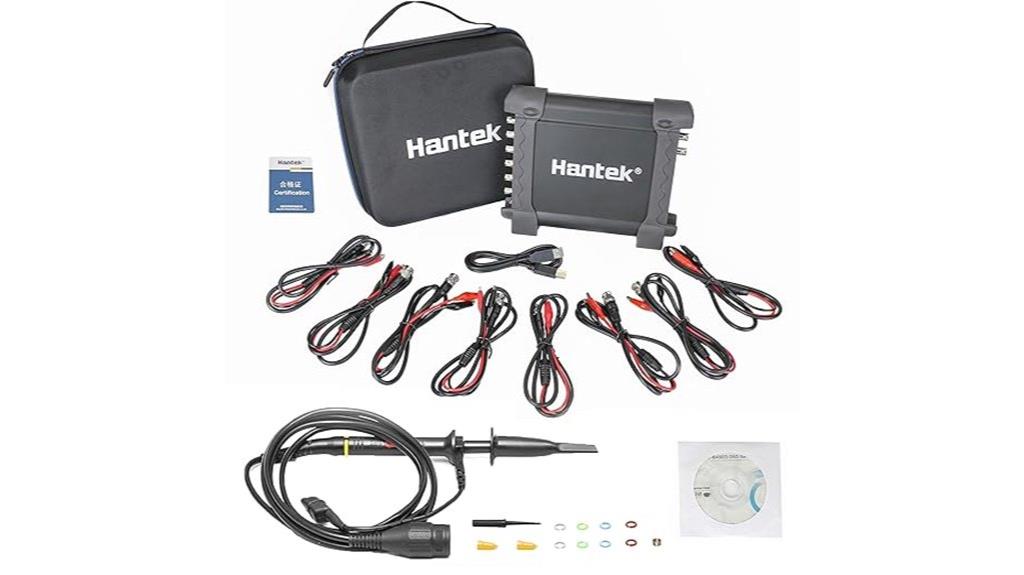
The Hantek 1008B stands out as an ideal choice for automotive technicians and enthusiasts seeking an affordable yet capable diagnostic tool. With 8 channels, it supports over 80 diagnostic functions, including ignition, sensors, and bus detection, making it versatile for vehicle troubleshooting. Its USB connectivity, waveform recording, and simulation features enhance diagnostic capabilities, while video help functions make it user-friendly. Although limited in bandwidth when all channels are used, it offers reliable hardware quality suitable for beginners and professionals alike. However, software can be basic, and Windows 11 compatibility issues may arise. Overall, it’s a solid entry-level scope for automotive diagnostics.
Best For: automotive technicians and enthusiasts looking for an affordable, versatile diagnostic oscilloscope suitable for basic to intermediate vehicle troubleshooting.
Pros:
- Supports over 80 diagnostic functions including ignition, sensors, and bus detection
- USB connectivity with waveform recording and simulation capabilities
- User-friendly features such as video help functions and pattern data saving
Cons:
- Limited bandwidth when all 8 channels are used simultaneously, restricting complex diagnostics
- Basic software with performance issues and limited functionality compared to hardware capabilities
- Compatibility problems with Windows 11, leading to driver errors and setup difficulties
Handheld Oscilloscope Multimeter with Waveform Generator
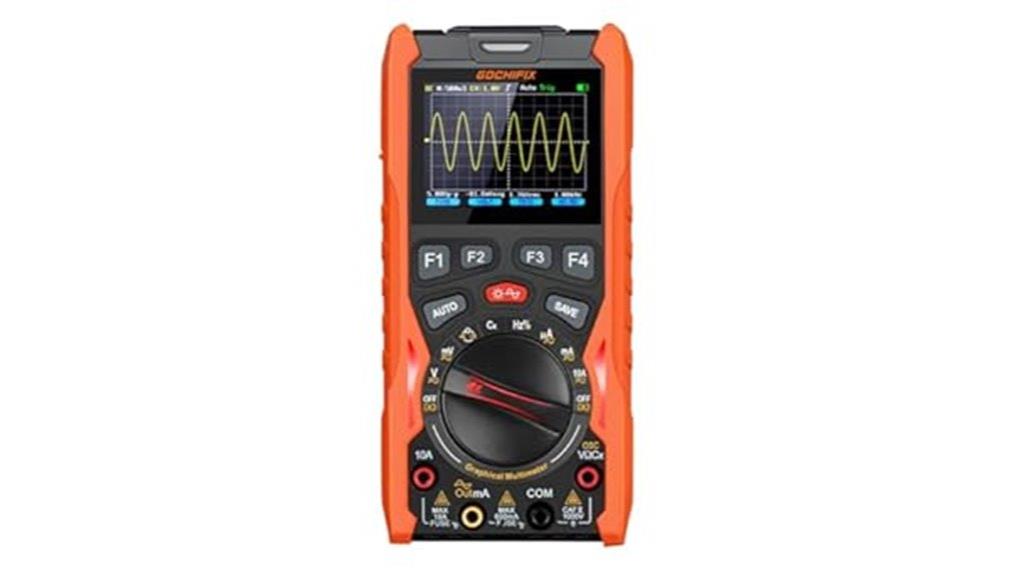
A handheld oscilloscope multimeter with a waveform generator is an excellent choice for technicians and hobbyists who need versatile testing tools in a portable package. It combines an oscilloscope, multimeter, and signal generator in one device, making on-site troubleshooting straightforward. With a 12MHz bandwidth, dual trace, and 50Msps sampling, it handles basic diagnostics effectively. Its compact design, rechargeable battery, and simple mode switching make it user-friendly. While not suited for high-frequency or professional-grade tasks, it excels for automotive, electronics, and generator testing, offering accurate measurements and waveform analysis in a lightweight, convenient format.
Best For: hobbyists, field technicians, and electronics enthusiasts seeking a portable, multi-functional testing device for basic diagnostics and troubleshooting.
Pros:
- Combines oscilloscope, multimeter, and waveform generator in a single portable unit for convenience.
- Easy to operate with straightforward mode switching and clear waveform display.
- Affordable with good build quality, suitable for on-site testing and basic diagnostics.
Cons:
- Limited bandwidth (up to 12MHz for scope, effective up to 50MHz with probes) not suitable for high-frequency professional applications.
- Slightly bulky for one-handed operation and less precise than high-end laboratory instruments.
- Not designed for high-precision measurements or advanced high-frequency analysis, with some limitations in accuracy and response time.
Hantek DSO2C10 Digital Storage Oscilloscope

If you’re looking for an affordable oscilloscope to assist with battery diagnostics, the Hantek DSO2C10 stands out thanks to its versatile features and user-friendly design. It offers a 100MHz bandwidth, dual channels, and a 1GSa/s sampling rate, making it suitable for various applications, including communication and embedded systems. The scope includes an internal signal generator, supports multiple trigger modes, and decodes serial protocols like I2C and CAN. Its compact, lightweight build makes it portable, while its color display and extensive measurement options help streamline testing. Though it has some limitations, like slower refresh rates, it provides great value for students, hobbyists, and small repair labs.
Best For: hobbyists, students, and small repair technicians seeking an affordable, versatile oscilloscope for basic electronic diagnostics and educational purposes.
Pros:
- Cost-effective with a wide range of features including serial protocol decoding and waveform storage
- Compact, lightweight design making it highly portable for bench use or fieldwork
- User-friendly interface with adjustable display and extensive measurement options
Cons:
- Slower refresh rate and display update speed due to hardware limitations
- Build quality feels cheap with a plastic chassis, less suitable for heavy-duty professional environments
- Potential configuration issues requiring careful setup and occasional power cycling
HDS2102S Oscilloscope, 100MHz Bandwidth 2+1 CH Digital Handheld Oscilloscope Multimeter

For professionals and hobbyists who need a portable, all-in-one testing tool, the HDS2102S oscilloscope stands out with its 100MHz bandwidth and 2+1 channel configuration. It combines an oscilloscope, multimeter, and waveform generator into a compact device, making troubleshooting quick and efficient in the field. Its 3.5-inch color LCD provides clear readings, even outdoors. With a 500MS/s sample rate, 8K record length, and high waveform refresh rate, it delivers precise measurements. Lightweight and ergonomic, it’s perfect for testing batteries, automotive systems, and electronics, offering versatility and ease of use for both professionals and enthusiasts.
Best For: professionals, technicians, and hobbyists seeking a portable, all-in-one testing tool for electronic diagnostics and troubleshooting in various field environments.
Pros:
- Combines oscilloscope, multimeter, and waveform generator in a compact, portable design
- High-resolution 3.5-inch color LCD ensures clear readings outdoors and in dim environments
- Fast refresh rate of 10,000 waveforms per second allows for accurate detection of intermittent signals
Cons:
- Limited bandwidth of 100MHz may not suit high-frequency signal analysis
- 8-bit vertical resolution might be insufficient for very precise measurements in some applications
- Small screen size could be restrictive for detailed waveform analysis compared to larger benchtop oscilloscopes
Siglent SDS1104X-E 100MHz Digital Oscilloscope

The Siglent SDS1104X-E stands out as an excellent choice for battery diagnostics due to its high-speed sampling and advanced triggering capabilities, which enable precise analysis of complex signals. Its 100 MHz bandwidth, combined with a 500 MSa/s sample rate and 256-level intensity grading display, ensures detailed waveform capture. Features like serial bus decoding, history waveform recording, and a 1 million point FFT make analyzing digital communication and spectral content straightforward. The scope’s user-friendly interface, robust build, and remote operation via Ethernet or USB add convenience. Overall, it offers professional-level performance at an affordable price, making it ideal for accurate, efficient battery diagnostics.
Best For: electronics hobbyists, students, and professionals who need accurate digital and analog circuit analysis, especially for digital communication protocols and battery diagnostics.
Pros:
- High sampling rate of 500 MSa/s with four channels for detailed waveform capture
- Advanced triggering, serial decoding, and FFT analysis for comprehensive signal analysis
- User-friendly interface with robust build quality and remote operation capabilities
Cons:
- Limited dynamic range due to 8-bit resolution, affecting small signal measurements within large signals
- Max bandwidth of 100 MHz, expandable to only 200 MHz with optional upgrades, which may be insufficient for higher-frequency applications
- No USB mouse or keyboard support, and the fan can be slightly loud during operation
Oscilloscope Handheld Digital Oscilloscope Kit

The Oscilloscope Handheld Digital Oscilloscope Kit stands out as an ideal choice for electronics hobbyists and technicians who need a portable, easy-to-use testing tool. Its compact design features a 2.4-inch TFT display, making it perfect for on-the-go diagnostics. The device supports a wide voltage sensitivity range from 5mV/div to 20V/div and can measure signals like PWM and monostable circuits accurately. With quick adjustments via a rotary encoder and included accessories like BNC cables and detailed instructions, it’s user-friendly. While it has some limitations—such as small display size and build fragility—it offers reliable performance for basic troubleshooting and circuit analysis.
Best For: electronics hobbyists and technicians seeking a portable, easy-to-use oscilloscope for basic circuit testing and troubleshooting on the go.
Pros:
- Compact and lightweight design ideal for portable use and fieldwork
- Supports a wide voltage sensitivity range from 5mV/div to 20V/div for versatile signal measurement
- Includes user-friendly features like a rotary encoder and detailed instructions, making it accessible for beginners
Cons:
- Small 2.4-inch display can make readings difficult to interpret accurately
- Build quality is modest and may be fragile or prone to damage with rough handling
- Limited upgradeability and lack of firmware updates restrict long-term functionality
Hantek 2C72 Handheld Oscilloscope & Multimeter (70MHz, 2CH, DMM)
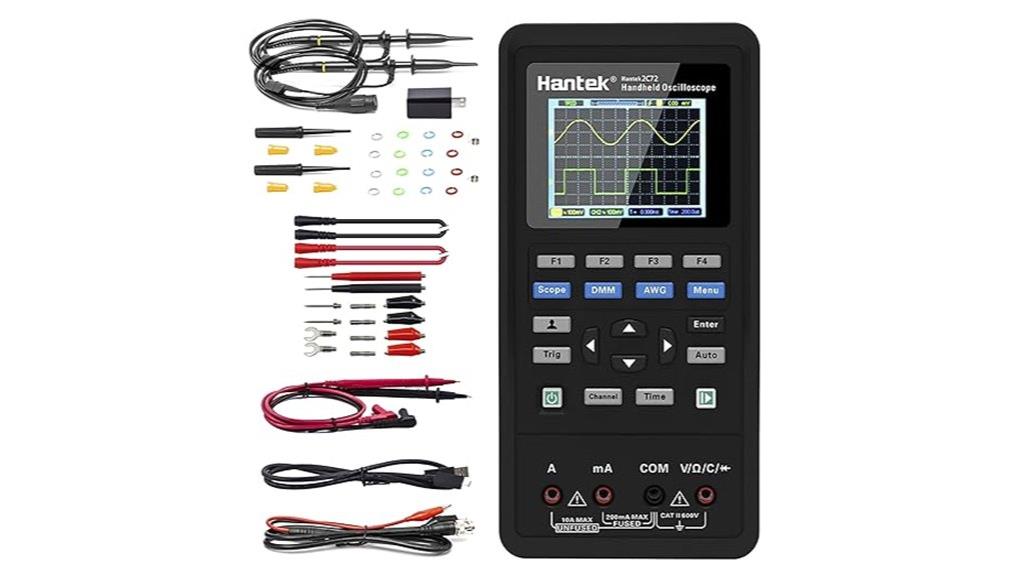
Looking for a portable oscilloscope that simplifies battery diagnostics? The Hantek 2C72 combines oscilloscope and multimeter functions in one compact device. It offers a 70MHz bandwidth, two channels, and high sampling rates up to 250MSa/s, making it ideal for precise measurements. With automatic frequency, amplitude, and waveform calibration, it’s easy to get accurate readings quickly. The device supports voltage, current, resistance, diode, capacitance, and continuity tests, plus overload protection. Its rechargeable Type-C power supply provides a full day of use after just two hours of charging. The high-resolution display and intuitive controls make it user-friendly, even in demanding environments.
Best For: professionals and hobbyists seeking a portable, versatile oscilloscope and multimeter for accurate on-the-go electrical diagnostics and measurements.
Pros:
- Combines oscilloscope and multimeter functions in a compact, portable design
- High bandwidth of 70MHz with advanced automatic measurement features for quick, precise readings
- Rechargeable via Type-C, offering a full day of continuous use after just two hours of charging
Cons:
- Limited to 2 channels, which may restrict complex waveform analysis
- May lack advanced features found in larger, benchtop oscilloscopes for detailed testing
- The impact-resistant shell, while durable, may increase the overall weight compared to simpler multimeters
Hantek DSO2D15 Digital Storage Oscilloscope
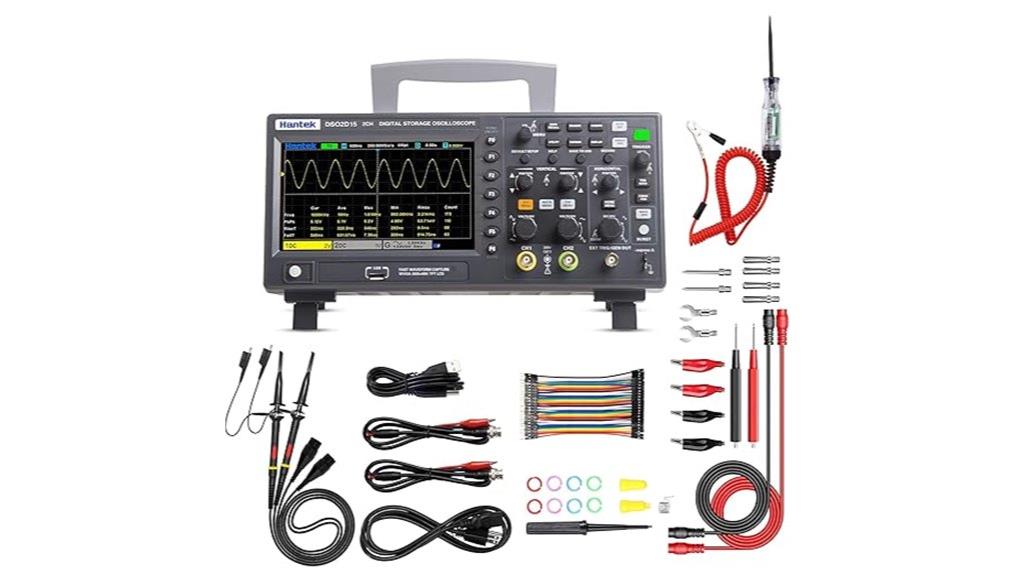
If you’re seeking an affordable yet capable oscilloscope for battery diagnostics, the Hantek DSO2D15 stands out with its 150MHz bandwidth and 8M memory depth, enabling detailed analysis of voltage fluctuations and transient behaviors. Its 1 GSa/s sampling rate captures high-frequency noise and slow signals effectively. With two independent channels and a built-in 25MHz waveform generator, it supports complex testing like protocol decoding for UART, I2C, SPI, and more. The bright 7-inch display makes waveform visualization easy, and its USB connectivity allows simple data storage and updates. Although some users note response delays and noise issues, it remains a solid choice for basic to intermediate battery testing.
Best For: hobbyists, students, and professionals seeking an affordable, versatile oscilloscope for basic to intermediate circuit analysis, waveform storage, and protocol decoding.
Pros:
- Offers 150MHz bandwidth and 8M memory depth for detailed signal analysis
- Built-in 25MHz waveform generator supports arbitrary waveforms and modulation
- Supports multiple protocol decoding (RS232/UART, I2C, SPI, CAN, LIN) for digital communication analysis
Cons:
- Response delays and occasional freezing can affect workflow stability
- Noise levels and RFI radiation may interfere with nearby radios and sensitive equipment
- Missing accessories like high-voltage probes and some users report limited internal input impedance control
6074BC Digital Oscilloscope 70MHz 1GSa/s 4CH USB Virtual Oscilloscope Diagnostic Instrument Diagnostic Tool
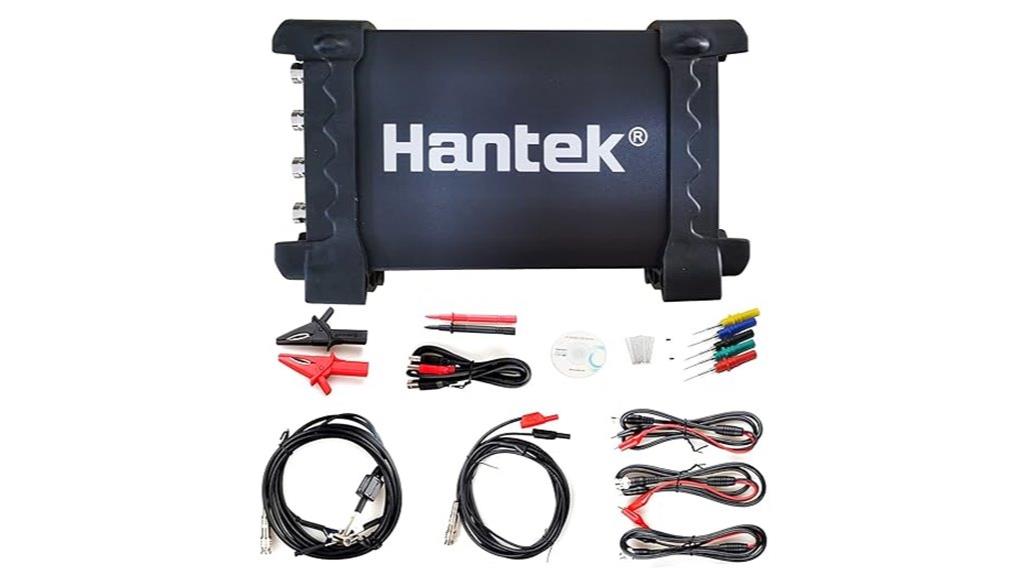
For technicians seeking a versatile and portable diagnostic tool, the 6074BC Digital Oscilloscope with 70MHz bandwidth and 1GSa/s sampling rate stands out. It offers four channels, high input sensitivity, and functions as a multimeter, waveform generator, and DMM, making it highly adaptable. Its USB plug-and-play design supports Windows systems and requires no external power, perfect for on-site diagnostics. With over 20 automatic measurement functions, waveform recording, and resourceful trigger options, it’s ideal for automotive diagnostics and fieldwork. Despite some software quirks, it delivers reliable performance at an affordable price, making it a practical choice for both beginners and pros.
Best For: technicians and hobbyists seeking a portable, versatile diagnostic oscilloscope suitable for automotive, field, and on-site troubleshooting with user-friendly features and moderate accuracy.
Pros:
- Offers 70MHz bandwidth and 1GSa/s sampling rate for reliable signal analysis
- Supports multiple functions including multimeter, waveform generator, and DMM in one device
- USB plug-and-play with compatibility across Windows systems, requiring no external power
Cons:
- Software can be unpolished with occasional recognition issues and bugs
- Some users experience setup difficulties or missing accessories
- Not as precise or feature-rich as high-end, professional oscilloscopes
Hantek DSO5102P Digital Storage Oscilloscope

The Hantek DSO5102P Digital Storage Oscilloscope is an excellent choice for those diagnosing batteries, thanks to its 100MHz bandwidth and 1GSa/s sampling rate. Its 40K record length and dual channels allow precise signal capture, while multiple trigger modes—including edge, pulse, and video—enhance measurement flexibility. The bright 7-inch WVGA display makes waveform analysis straightforward, and built-in math functions like FFT support exhaustive testing. With USB connectivity, you can control it remotely and save data easily. Compact and user-friendly, the scope is ideal for hobbyists and professionals alike, providing reliable performance for accurate battery diagnostics.
Best For: Hobbyists and professionals seeking an affordable, reliable oscilloscope for diagnosing electronic components, batteries, and various electrical systems.
Pros:
- High sampling rate of 1GSa/s ensures precise waveform capture.
- Intuitive 7-inch WVGA display facilitates easy signal analysis.
- Multiple trigger modes and math functions like FFT provide comprehensive testing options.
Cons:
- USB data transfer can be slow, limiting real-time PC analysis.
- Build quality issues, such as the power button, may affect durability.
- Lack of internal cooling could lead to overheating during extended use.
Hantek 6022BE Digital Oscilloscope USB PC-Based 2 Channels

The Hantek 6022BE Digital Oscilloscope stands out as an affordable and portable option ideal for hobbyists and beginners troubleshooting simple circuits. It’s USB-based, with 2 channels and a 20MHz bandwidth, making it suitable for basic signal analysis on Windows 10 and Android devices. The device includes 23 measurement functions, like waveform averaging and PASS/FAIL checks, and comes with probes rated up to 35V. Compact and rugged, it’s easy to set up and operate, especially for low-cost learning projects. However, its software can be unstable, and long-duration waveform display is limited, so it’s best suited for basic testing rather than advanced diagnostics.
Best For: hobbyists, beginners, and students seeking an affordable, portable oscilloscope for basic circuit troubleshooting and educational projects.
Pros:
- Compact, lightweight, and easy to set up for quick testing.
- Silent operation with no noisy fans, suitable for quiet environments.
- Includes useful measurement functions like waveform averaging and PASS/FAIL checks at an affordable price.
Cons:
- Software can be unstable, with freezing and display glitches requiring restarts.
- Limited long-duration waveform display and measurement accuracy at low frequencies.
- Cannot display phase angle, perform FFT analysis, or handle signals above 35V without external attenuation.
Oscilloscope

An ultra-portable oscilloscope with a compact size that fits into a shirt pocket stands out as an ideal tool for battery diagnostics on the go. It features 2 analog channels, up to 100 MHz bandwidth, and a 1 GSa/s sampling rate, powered via USB-C for fast data transfer. Its FPGA-based hardware offers extensive memory, enabling detailed waveform capture, while the open-source DSView software provides spectrum analysis and user-friendly operation across Windows, macOS, and Linux. Despite some limitations like a 10V voltage cap and fewer math functions, its stability, responsiveness, and portability make it perfect for quick diagnostics, hobbyist projects, and educational use.
Best For: hobbyists, educators, and field technicians seeking a portable, easy-to-use oscilloscope for quick diagnostics and low-power electronics testing.
Pros:
- Compact, lightweight design fits into a shirt pocket for maximum portability
- Fast data transfer via USB-C and stable operation across Windows, macOS, and Linux
- Large onboard memory and high sampling rate enable detailed waveform capture and analysis
Cons:
- Restricted maximum voltage measurement of 10V, limiting use with higher-voltage circuits
- Fewer advanced math functions compared to higher-end oscilloscopes
- Limited voltage range and some noise susceptibility due to USB power source
ANCEL PB600 Power Circuit Probe Tester with Battery, Relay, Injector Test, 8-35V Automotive Electrical Circuit Tester, Multimeter/Oscilloscope/Ohmmeters Power Circuit Probe Kit, 30FT Cable

If you’re looking for a versatile tool that combines battery diagnostics with advanced circuit testing, the ANCEL PB600 Power Circuit Probe Tester is an excellent choice. It offers multi-functionality, including voltage, resistance, diode testing, and component activation, making it suitable for various automotive repairs. Its ability to test batteries, starters, and alternators simultaneously helps prevent costly failures. With a flexible 30-foot cable and support for circuits up to 35V, it’s perfect for reaching hard-to-access areas. The device also features oscilloscope capabilities, allowing precise waveform analysis for fuel injectors and ignition systems, streamlining diagnostics for both professionals and DIY enthusiasts.
Best For: automotive professionals, DIY enthusiasts, and maintenance workers seeking comprehensive electrical testing and diagnostics tools.
Pros:
- Combines multiple functions including voltage, resistance, diode testing, and component activation in one device
- Supports battery, starter, and alternator diagnostics to prevent costly repairs
- Features oscilloscope capabilities for precise waveform analysis of injectors and ignition systems
Cons:
- May be complex for beginners without prior electrical testing experience
- Requires familiarity with vehicle electrical systems to maximize utility
- The extensive feature set and accessories could be overwhelming for casual users
Factors to Consider When Choosing an Oscilloscope for Battery Diagnostics

When selecting an oscilloscope for battery diagnostics, I focus on key factors like measurement accuracy, voltage compatibility, and sampling speed to guarantee reliable results. Portability and software features also matter, especially if I need to work in different locations or analyze data easily. By considering these points, I can choose a tool that fits my specific testing needs perfectly.
Measurement Accuracy and Range
Choosing an oscilloscope for battery diagnostics hinges on its measurement accuracy and range, as these factors directly impact the reliability of your readings. A device with at least 70MHz bandwidth ensures it captures fast transient voltage spikes accurately, which are common in battery circuits. A high sampling rate, around 100MSa/s or more, prevents aliasing and allows precise measurement of rapid voltage changes. It’s also essential that the oscilloscope offers a wide voltage measurement range, from millivolts to hundreds of volts, to handle various battery types and testing scenarios. Reliable trigger functions help capture specific voltage events, while calibration options or built-in accuracy specs guarantee consistent, trustworthy readings over time. These features together ensure your diagnostics are precise and dependable.
Voltage Compatibility
Verifying voltage compatibility is crucial when selecting an oscilloscope for battery diagnostics. You need to confirm that the maximum voltage rating of the scope exceeds your battery system’s highest voltage, typically up to 12V or 24V for automotive batteries. Using high-voltage probes or attenuation features allows safe measurement of voltages above the scope’s standard input range. It’s also essential to verify the scope’s ability to measure low voltages accurately, such as sensor signals, which may require millivolt sensitivity. Additionally, check the input impedance and bandwidth to ensure accurate readings without disturbing the circuit or causing errors. Finally, verify the oscilloscope’s voltage measurement capabilities are compatible with other testing tools you might use, such as multimeters or automotive probes.
Sampling Speed and Resolution
Sampling speed and resolution directly impact how accurately a scope can capture and display battery signals. Higher sampling speeds, like 1 GSa/s or more, allow me to detect fast transient events that could indicate issues. The resolution, measured in bits, determines how detailed the voltage measurements are; higher resolution, such as 12-bit, provides clearer, more precise waveforms. To prevent aliasing and ensure signal integrity, I need a sampling rate at least twice the highest frequency component, following the Nyquist theorem. For subtle voltage fluctuations, a scope with a sampling rate above 50 MSa/s and higher resolution helps reveal small signal variations. Low sampling speeds or resolutions risk missing critical transient behaviors, leading to incomplete or inaccurate diagnostics.
Portability and Ease
When diagnosing batteries in the field, portability and ease of use become critical factors in selecting the right oscilloscope. A lightweight, compact design makes handling and transporting the device effortless, especially during on-site repairs or remote testing. Built-in rechargeable batteries with high capacity—like 6000 mAh or more—allow for several hours of continuous operation, minimizing interruptions. User-friendly interfaces, such as touchscreens or simple controls, enable quick setup and adjustments, even in challenging environments. Integrated storage and connectivity options streamline data saving and transfer while working on battery power. Overall, choosing an oscilloscope that balances portability with ease of use ensures efficient, accurate diagnostics without sacrificing convenience in the field.
Software and Connectivity
Choosing the right oscilloscope for battery diagnostics heavily depends on its connectivity options and software capabilities. I look for models that support USB, Ethernet, or Wi-Fi, making data transfer, remote control, and firmware updates straightforward. Compatibility with multiple operating systems like Windows, macOS, or Linux is essential to seamlessly integrate into my workflow. I prioritize scopes with software that offers waveform analysis, protocol decoding, and measurement tools for exhaustive diagnostics. Open-source or regularly updated manufacturer software is a plus, ensuring I have bug fixes and new features. Additionally, features like screenshot saving, waveform exporting, and real-time data logging are critical for effective troubleshooting. These factors streamline testing and improve diagnostic accuracy, saving me time and effort.
Safety and Durability
Selecting an oscilloscope for battery diagnostics means prioritizing durability and safety features that can handle demanding environments. I look for a device with a tough, impact-resistant casing that resists dust and moisture, perfect for field testing. Safety is equally critical; features like overload protection, insulated probes, and high-voltage tolerance up to 4000V help prevent electrical hazards. I prefer models with quality connectors, reinforced cables, and proper grounding options, reducing the risk of damage from regular use. A reliable build, including a sturdy chassis and reinforced display, ensures longevity. Long-term durability is supported by a robust power source, like built-in rechargeable batteries, so the device remains dependable over time. These factors ensure safe, consistent testing in any environment.
Frequently Asked Questions
How Do Oscilloscopes Differentiate Between Battery Types During Testing?
Oscilloscopes differentiate between battery types by analyzing their voltage and current waveforms during testing. I observe specific patterns, like voltage spikes or discharge curves, that vary with battery chemistry. By comparing these signals to known profiles, I can identify whether it’s a lithium-ion, nickel-metal hydride, or lead-acid battery. This helps me guarantee accurate diagnostics and ideal performance for each battery type.
What Is the Ideal Bandwidth for Automotive Battery Diagnostics?
The ideal bandwidth for automotive battery diagnostics is around 100 MHz. I’ve seen oscilloscopes with this range capture even the tiniest voltage fluctuations, making diagnostics incredibly precise. Anything lower might miss critical details, while higher bandwidths could introduce noise. For most automotive applications, 100 MHz hits the sweet spot—fast enough to catch transient events, yet manageable for accurate readings. Trust me, it’s a game changer.
Can Handheld Oscilloscopes Provide Laboratory-Grade Accuracy?
Handheld oscilloscopes can offer impressive accuracy, but they usually don’t match laboratory-grade instruments. I’ve found that while modern handhelds are portable and convenient, their precision and stability might fall short for highly detailed diagnostics. If you’re aiming for the most accurate readings, especially in complex battery testing, a benchtop or professional-grade oscilloscope is still the best choice. However, for quick checks, handhelds work surprisingly well.
How Do Probe Types Affect Measurement Precision in Battery Testing?
Probe types critically impact measurement precision in battery testing. I find that high-impedance, active probes minimize signal loading and noise, giving more accurate readings. Passive probes are simpler but can introduce errors at high frequencies or with sensitive signals. Choosing the right probe depends on the test’s complexity; I recommend using active probes for detailed diagnostics to guarantee precise, reliable measurements, especially when testing delicate battery circuits.
Are There Specific Features That Enhance Battery Diagnostic Capabilities?
Powerful features profoundly improve battery diagnostics. I look for oscilloscopes with precise pulse capture, high sampling rates, and advanced filtering. These tools help me identify subtle voltage drops and transient issues quickly. Built-in measurement functions, like auto-trigger and waveform analysis, streamline testing. With these capabilities, I can confidently diagnose battery health, ensuring accurate, efficient, and easy inspections that keep my projects running smoothly.
Conclusion
Choosing the right oscilloscope can truly transform your battery diagnostics, making testing faster and more accurate. Did you know that using a proper oscilloscope can improve diagnostic precision by up to 30%? Whether you’re a professional or a hobbyist, investing in the right tool guarantees reliable results and peace of mind. So, take your time, consider your needs carefully, and you’ll be well on your way to mastering battery testing with confidence.

